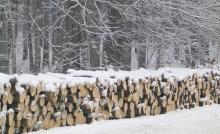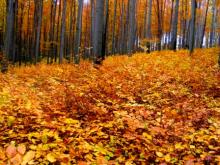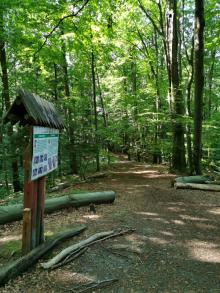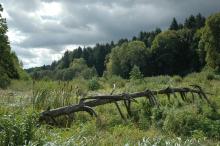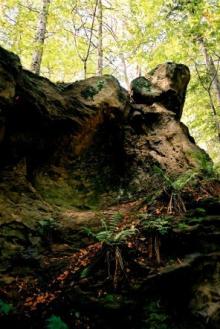 Asset Publisher
Asset Publisher
Polish forests
Poland is in the European lead, while concerning the area of all forests. They cover about 29,2 % of the country territory, and grow within the area of 9,1 million hectares. The overwhelming majority of the forests is state owned, of which almost 7,6 million hectares are managed by the State Forests National Forest Holding..
The number of Polish forest is still growing. The forestation rate of the country has increased from 21 % in 1945 to 29,2 % at the moment. Between 1995 and 2008, the forest area increased by 310 thousand ha. The basis for afforestation works is the "National Programme for Increasing the Forest Cover" (KPZL), assuming an increase of the forestation rate up to 30 % by 2020 and up to 33 % by 2050. Polish forests abound in flora, fauna and fungi. 65 % of the total number of animal species live there.
The forests grow in our country on poor soils, mainly because of the development of the agriculture in previous years. It influences the distribution of the types of the forest sites in Poland. Over 55 % of the forest areas is covered with coniferous forests. In other areas, there are forest sites, mainly the mixed ones. Their small part constitute alder and riparian forests – not more than 3 %.
In the years 1945 – 2011 the area of natural deciduous tree stands within the area of the State Forests National Forest Holding increased from 13 to 28,2 %.
Within the lowlands and uplands the most often occurring tee species is pine. It covers 64,3 % of the forest area of the State Forests National Forest Holding and 57,7 % of private and commune forests. In the mountains the predominant species is European spruce ( in the west) and European spruce with beech (in the east). Domination of pine is the result of carrying on sustainable forest management in the past. Once, the monocultures (crops or cultivations of one species) were the answer to the great demand of industry for wood. Such forests appeared to be quite fragile to climatic factors. They also were often the prey of pests' expansion.
In Polish forests, the share of other tree species, especially deciduous trees have been systematically increasing. The foresters have stepped aside from monocultures – that is why, they try to fit specific species of the forest stand to the natural stand, that would be proper for the given area. Thanks to that, in the years 1945 – 2011, the area of the deciduous tree stands within the lands of the State Forests National Forest Holding increased from 13 to 28,2 %. There occur more and more frequently the following tree species: oaks, ashes, maples, sycamore maples, elms, but also birches, beeches, alders, poplars, hornbeams, aspens, tilias and willows.
Our forests are the most often represented by the forest stands aged 40 to 80 years. The average age of the forest equals 60 years. More and more trees are of big size at the age over 80 years. Since the end of the Second World War, the forests' area has increased up to almost 1,85 million hectares.
Raport o stanie lasów w Polsce 2012
 Asset Publisher
Asset Publisher
IV edycja akcji #sadziMY za nami
IV edycja akcji #sadziMY za nami
 Fot. Na zdjęciu uczestnicy akcji #sadziMY odbierający sadzonki drzew
Fot. Na zdjęciu uczestnicy akcji #sadziMY odbierający sadzonki drzew
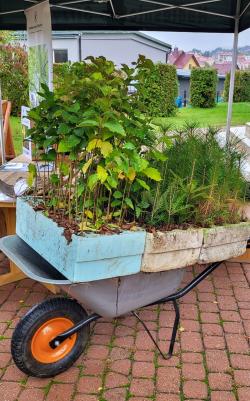 Fot. 2 Na zdjęciu sadzonki drzew w kontenerach ustawione na taczkach pod namiotem Nadleśnictwa Strzyżów
Fot. 2 Na zdjęciu sadzonki drzew w kontenerach ustawione na taczkach pod namiotem Nadleśnictwa Strzyżów
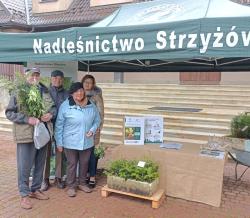 Fot. 3 Grupa seniorów odbierających sadzonki drzew w ramach akcji #sadziMY
Fot. 3 Grupa seniorów odbierających sadzonki drzew w ramach akcji #sadziMY
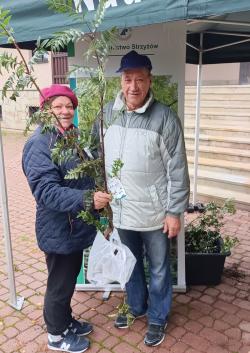 Fot. 4 Małżeństwo emerytów z sadzonkami drzew otrzymanymi w ramach akcji #sadziMY
Fot. 4 Małżeństwo emerytów z sadzonkami drzew otrzymanymi w ramach akcji #sadziMY
Rozdaliśmy 500 sztuk sadzonek drzew.
W dniach 29-30 września odbyła się ogólnopolska akcja #sadziMY w ramach której we wszystkich nadleśnictwach w Polsce leśnicy rozdawali nieodpłatnie sadzonki drzew i krzewów. Punkt kulminacyjny akcji #sadziMY miał miejsce w piątek 30 września w okolicach Nowego Sącza. Tam drzewa sadziła para prezydencka. Prezydent Andrzej Duda i jego żona Agata Kornhauser-Duda patronują przedsięwzięciu od jego pierwszej edycji, ale także własnym przykładem, zachęcają do działania.
Po raz czwarty leśnicy włączyli się w akcję, dzięki czemu każdy chętny mógł otrzymać sadzonkę i zasadzić ją na własnej działce. To idea bliska każdemu leśnikowi i przyrodnikowi.
Corocznie sadzimy w lasach 500 mln drzew. Dzięki naszej pracy rośnie powierzchnia lasów i ich zasobność. Ale wszyscy Polacy mogą nam pomóc w tym, by drzew w kraju było jak najwięcej. Zachęcam, by wziąć drzewko od leśników i posadzić je na własnej działce, przy domu czy tam, gdzie pracujemy – mówi Józef Kubica, p.o. dyrektor generalny Lasów Państwowych.

W Nadleśnictwie Strzyżów rozdaliśmy 500 sztuk sadzonek, takich gatunków jak: sosna zwyczajna, wiąz szypułkowy, jodła pospolita, jarząb pospolity, głóg, rokitnik oraz kalina koralowa. Mimo deszczowej pogody akcja cieszyła się zainteresowaniem. Chętnie odbierane były, zarówno gatunki typowo leśne jak jodła, sosna i wiąz do uzupełnienia na uprawach leśnych, jak i drzewka jarzębiny i głogu oraz krzew kaliny do posadzenia w przydomowych ogrodach. Osoby, w ręce których trafiały sadzonki drzew, podpytywały leśników o wybrane gatunki, chcąc uzyskać fachową wiedzę na temat ich biologii, cech wzrostu czy wymagań. Czy to na działce, w ogrodzie czy w lesie, każde zasadzone drzewo będzie miało korzystny wpływ na nasze otoczenie, a tym samym na jakość naszego życia. Oczyści powietrze z zawiesin i pyłów, odwdzięczy się cieniem w letnie upały, uspokoi szumem skołatane nerwy, pokoloruje szary jesienny krajobraz, będzie miejscem gniazdowania i schronieniem dla ptaków, dostarczy pokarmu w postaci owoców i nasion ptakom i innym zwierzętom, będzie wyrazem naszej dbałości o środowisko, w którym żyjemy.


 fot. Paweł Fabijański
fot. Paweł Fabijański
 fot. Paweł Fabijański
fot. Paweł Fabijański
 fot. Paweł Fabijański
fot. Paweł Fabijański

